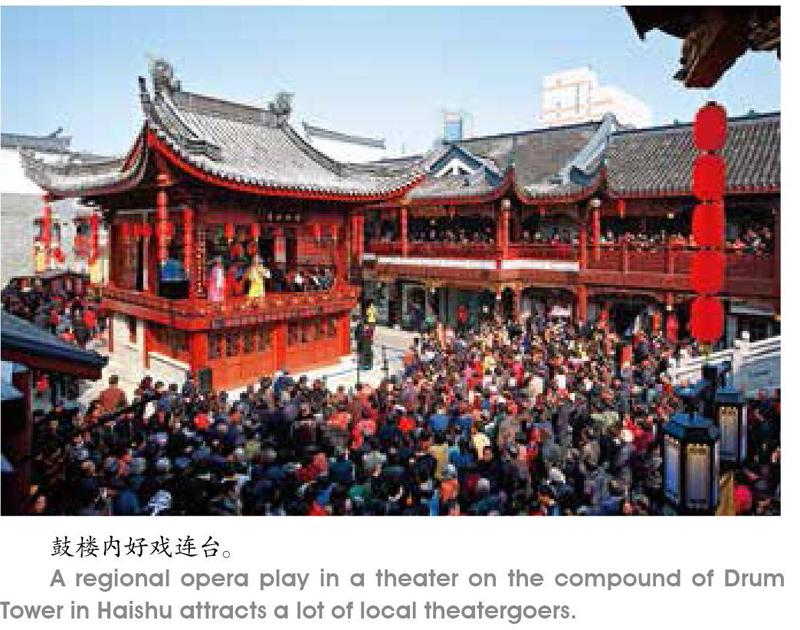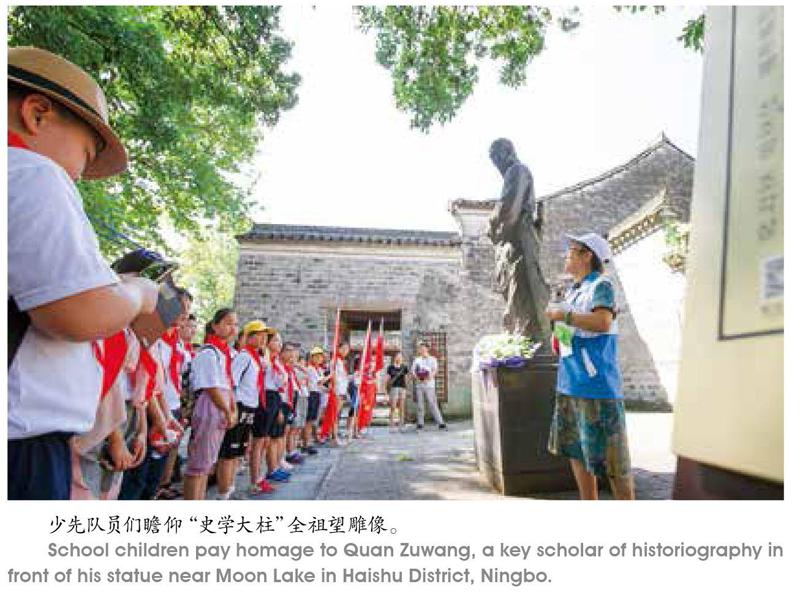海曙:历史街区在城市变迁中重新发光
2018-05-09续大治朱尹莹
续大治?朱尹莹

“天封塔、鼓楼沿,东南西北通走遍”,这句老话在浙江宁波的百姓中耳熟能详。鲜为人知的是,宁波现存的八大历史街区中,有7个在海曙区。上面老话中的天封塔、鼓楼也都在海曙区管辖范围内。近年来,作为宁波历史文化名城核心区所在地的海曙区,探索历史街区多元保护与文化旅游商业融合之道,取得了成功经验。
活态文脉且留下
“不夸张地说,很多宁波的‘老底子都能在海曙寻根溯源。”海曙区文广新局负责人对海曙的文化遗产,可谓如数家珍,“我们拥有全国、省、市级文物保护单位29处,区级文物保护单位104处,市、区级文物保护点220处,文物资源总量位列全市第一。”
十一五期间,海曙区提出了两个功能定位,一个是中心商贸商务区,一个是历史文化名城核心区。“历史文化是不可复制的,是‘挖不走的资源,这就是海曙的竞争力、软实力。”海曙区委宣传部负责人说,这一功能定位给海曙的发展指明了方向。
2008年,以郁家巷历史街区为试点,海曙区正式实施历史街区改造。10年来,这些历史街区不仅充分运用“原地保护、原貌迁建、空间转换、风格内饰、科技渗透”等各种设计改造手法“修旧如旧”,完整地保留了原汁原味的历史文化风貌,更赋予其活色生香的现代都市活力,成为一道道靓丽的都市风景线。
郁家巷的歷史最早可追溯到南宋时期,一直位于宁波内城核心,历来是名门旺族的聚集之地,现存白水巷、带河巷、郁家巷等宁波最古老、最本质、最纯正的街巷,也是宁波古城代表——月湖和日湖的中心连接点。
从巷口出发只需步行几十米,就走到郁家巷2号门牌下,这里就是曾经的近性楼,现在的盛世花厅。它的主人原是清朝同治、光绪年间的诸生林延鳌,后易主归学政盛炳维所有,盛炳维将其辟为书房,藏书十万,盛世花厅因此得名。
2008年,海曙区开始对历史街区实施改造探索,郁家巷成为试点。到2010年,经过2年筹建开发的“月湖盛园”,成为国内首个以江南院落为蓝本打造的历史文化商业街区,让郁家巷的老底子依旧,却又生机勃发。
南塘河是宁波的母亲河,从四明山麓流淌而来,绕古城南廓而入,与其他塘河织就一张密布的水网。这样的地理位置,也让南门形成了宁波最早的商业集市,其中心地带,就是南郊路,现在的南塘老街。
为中国电影作出巨大贡献的电影大师袁牧之曾生活在南塘河边上。他的故居是南郊路规模最大的民宅之一,建筑面积有820平方米,轮廓方正,高高的烽火墙印证着当年不凡的气派。
袁牧之在上世纪30年代投身戏剧事业,舞台上有“千面人”之美称。1934年编导创作《桃李劫》并担任主演。1937年编导的《马路天使》成为中国电影的标志性作品。1949年后任中华人民共和国中央电影局第一任局长。就在袁牧之百年诞辰之际,《南塘河历史街区保护性详细规划》编制完成。
2012年1月,南塘老街一期开街,二期于2015年9月亮相。绵延1.2公里的老街修复了袁牧之故居、同茂记、关圣殿等古祠、古庙、古宅、古商铺,还原了“前街后河”、“前店后场”的建筑景观。如今,这里已成为“集历史古迹、旅游观光、文化休闲、特色餐饮、百年老店、名优特及民俗特色于一体,体现宁波江南水乡城市特征”的历史文化特色商业街区。
百年书缘今续上
历史文化街区多元化改造模式的成功尝试,让海曙在历史街区活化保护利用的路子上越走越宽,文、商、旅互动文章越做越好。

“一部宁波史,半部在月湖”。月湖历史街区是宁波千百年来的文化中心,历代达官显贵均选择湖上安家,其中不乏宁波商业巨子。青石街55、60、62号的洪宅,经过修缮后依然坐落在原地。这座民国建筑的主体坐西朝东,大门朝东,进内为一三合院,它的主人就是当时太丰面粉厂的总经理洪宸笙。
太丰面粉厂在宁波工业史上曾书写了重重一笔。“当年,宁波民族工业一共有‘三支半烟囱,太丰就是其中的半支。”熟悉宁波历史的老人们常常对此津津乐道。
洪宸笙是太丰面粉厂的一个重要股东。原来的老板因为经营不善,把厂出让给了洪宸笙等13人。1941年4月19日,宁波沦陷。洪宸笙到上海租界避居,太丰厂也随之停工。三年后,日本人得知洪宸笙在上海的住址,上门胁迫令其恢复生产。洪宸笙坚持不回宁波,但为防止日本人全面掠夺太丰厂,就虚与委蛇,找人回宁波复工。名为复工,实则仅开一部车,每天只生产一二百包面粉而已。
一直到1945年抗战胜利后,洪宸笙回到了位于青石街的老家,太丰厂才正式复工了。1949年后,洪宸笙主动向解放军提供面粉,解决了部队的军粮问题。
宁波本土书店枫林晚在今年1月入驻了月湖西区的延寿堂,这幢老房子建于1932年,它曾经的主人是“一言堂”百货的老板刘延寿。当年的“一言堂”是宁波城区规模最大的百货店,当时还有一段流行的顺口溜:“一言堂百货多,良心堂药材多,三法卿钞票多,四明药房西药多……”
枫林晚总经理郑永宏在装修书店的过程中查阅了各种资料,发现“一言堂”最早是一家书业老字号——“宁波一言堂书庄”。枫林晚书店和一言堂书庄,相隔近百年的书缘竟这样续上了。
总投资15亿元的月湖西区保护和更新启动区项目启动以来,一直在探索“历史街区的保护和区域经济的融合发展,以及老城区的转型升级与新兴产业融合”的路子。月湖“金汇小镇”选择在最能体现宁波城市传统风貌的月湖“落户”,正是这种探索的成功之笔。目前,月湖金汇小镇已累计入驻企业464家,注册资金达441.14亿元,入驻率达50%。
鼓楼历史街区以宁波硕果仅存的古城楼为标志,从2012年开始有机更新后,通过业态转型、活动推动等各项工作,打造出“老宁波剪影,新宁波印象”,成为宁波人文化休闲体验的重要目的地。近日,该街区成功入选2017年度浙江省文化创意街区,为宁波历史文化名城增添了一张靓丽名片。
社会关注度和美誉度与日俱增的还有南塘河历史文化街区。据不完全统计,该街区去年客流量约400万人次。这条1.3公里长的街区被游客誉为“最有宁波味道的街区”,去年被评为宁波市级(培育)文创产业园区。
智慧服务入老城
2016年9月,海曙区发布了全国首个历史文化街区地方标准规范——《历史文化街区建设活动和服务管理指南》,标准涉及历史文化街区的保护建设、街区街貌、街区服务和街区管理等四方面要求,通过规范硬件设施、文物保护、民俗活动、商业规范等方面,提高街区规划合理性和服务管理水平,有效推动和规范辖区内7个历史文化街区的保护与建设。
去年以来,海曙历史文化街区保护利用更是动作频频:宁波老城内仅存的保存最完整的两片历史文化街区之一——伏跗室永寿街历史文化街区保护规划出台,将打造具有浓厚宁波传统文化氛围的宜居生活社区。
如今,海曙已开启“互联网+”街区建设的新模式,明确开展街区智慧服务建设,实现街区免费WIFI信号覆盖,通过手机APP平台、二维码扫描等实现街区管理与服务的接入。
“歷史街区改造,不仅是文化传承和设施更新,更应该让老百姓感受到实实在在的变化,否则保护就成了一句空话。”海曙区委宣传部负责人说,“最大程度保留历史街区的真实性、完整性和延续性,依靠老街区、老字号、老传统和老品牌,加大发掘、保护和开发力度,使分散的、隐性的历史文化资源集聚化、显现化,形成具有海曙特色的老城保护典范。”
(本文图片由海曙区委宣传部提供)
It is not exaggerating to say the Haishu District, that hosts as many as 29 cultural units above the city level and 104 historical and cultural sites under district-level protection, is the ‘cultural nucleus of Ningbo, a port city in eastern Zhejiang. According to the Information Office of Haishu District, the developmental goal of the district during the 11th ‘five-year period is to intensify its function as a CBD as well as the citys historic and cultural core. Essentially, the goal is to maintain the districts ‘soft power.
The reconstruction of the districts historic blocks started in 2008. Over the years, the original charm of an array of cultural spots has been restored, adding a refreshing touch to the citys modern skyline.
With a history dating back to the Southern Song Dynasty (1127-1279), Yujiaxiang had long been a neighborhood hosting the citys ‘blue blood clan. Today, the area is still the pivot of the old town of Ningbo, strewn with a network of ancient alleys that encapsulate the citys lesser-known historic essence. It is also the place where the citys two scenic landmarks – Moon Lake and Sun Lake, adjoin each other.
In 2008, Yujiaxiang was chosen as a venue for a pilot reconstruction project. The first phase of the project reached its finish line two years later with the launch of Chinas first ‘Jiangnan courtyard style historical street.
Ningbo is the hometown of Yuan Muzhi, a major figure in Chinas film industry. Yuans second film, (1937), starred then-unknown Zhou Xuan, who became one of Chinas most adored divas for the remainder of her life. is considered one of the most important Chinese films of all time. Nantang River, the ‘mother river of Ningbo, constituted a special part in the director/actors childhood memory. His former residence is a sprawling dwelling located on todays Nanjiao Road.
In the old times, Nantang was the citys commercial center. The first and second phases of the reconstruction of Nantang took six years to complete. Stretching 1.2km, the remolded street is dotted with time-honored stores, temples and former residences bearing the unmistakable imprint of their owners and displaying unique traditional Ningbo features.
The indisputable ‘leading lady of the urban vista of Ningbo, the Moon Lake not only presents the citys most distinct scenic highlight, but also plays an important role in the cultural subconscious of the locals. The lake area has been the ‘cultural hub of Ningbo throughout much of the citys history. It was once the ‘rich zone that appealed to prominent officials and eminent personages. One of the mansions here was built by Hong Chensheng, the owner of Taifeng Flourmill and one of the richest men in Ningbo in his time. The entrepreneur and his flourmill is not only a fascinating chapter in the history of the national industry of Ningbo but also a memorable chapter in the history of the citys war efforts against Japanese aggression in World War Two. In the 1950s, the flourmill became an important source of army provisions.
First built in 1932, Yan Shou Tang was once the residence of Liu Yanshou, the owner of the largest department store in Ningbo in the 1930s. The property now hosts a popular bookstore.
With a total capital investment of 1.5 billion yuan, the Moon Lake project works to explore a new mode of old town protection and reconstruction. One of the results of such exploration is the rise of Jinhui Town, a bustling area that now hosts as many as 464 enterprises bringing in a total registered capital topping 44 billion yuan.
The reconstruction of the citys Drum Tower historical block kicked off in 2012. The refurbished block ranked among “the best cultural innovation blocks in Zhejiang Province” in 2017.
Haishu District released Chinas first regional-level standard targeting old town reconstruction in September 2016. The standard is used for the protection and rebuilding of seven historical blocks within the Haishu territory, with a high-performance “Internet +” schema woven into the management of the blocks to ensure infrastructural readiness and service quality.
The reconstruction of old town areas is not only about cultural inheritance and facility upgrading but also about bringing tangible benefits to people living in this area, which is a consensus reached by all relevant departments of the district government.
